February 24, 2016
A dual-rate optical transceiver means that an optical transceiver can support two different data rates. Users could use dual-rate optical transceivers to achieve the full forward and backward compatibility of their systems, which helps them save a lot. The common dual-rate optical transceivers in today's market is the 1G/10G dual-rate SFP+ transceiver. In this post, we will give a brief introduction to this kind of dual-rate transceiver.
1/10G dual-rate SFP+ transceivers are designed for use in 1-Gigabit and 10-Gigabit Ethernet links over single-mode fiber (SMF) or multi-mode fiber (MMF). They are compliant with SFF-8431, IEEE 802.3-2005 10GBASE-SR/SW, 10GBASE-LR and 1000BASE-SX, 1000BASE-LX. Digital diagnostics monitoring (DDM) or digital optical monitoring (DOM) functions are available in dual-rate SFP+ transceivers via a 2-wire serial interface as specified in SFF-8472, so users can monitor many parameters of the transceiver module in real-time. There are many different vendors to supply 1G/10G dual-rate SFP+ transceiver, but the standards and protocols which they complied with are the same. The picture below shows an Intel E10GSFPSR 1/10G dual-rate SFP+ transceiver.
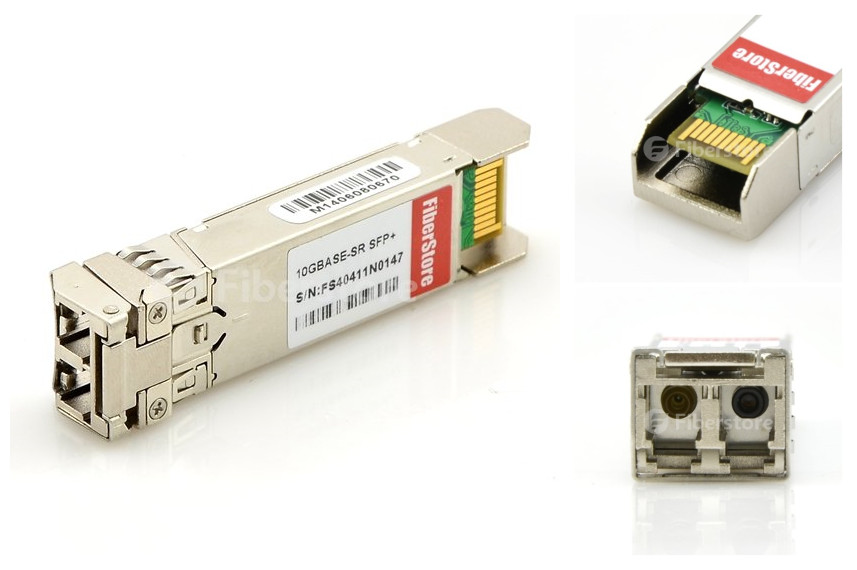
1G/10G dual-rate 10GBASE-LR and 1000BASE-LX SFP+ transceivers are designed for use in 1-Gigabit and 10-Gigabit Ethernet links up to 10km over SMF. They are compliant with SFF-8431, IEEE 802.3-2005 10GBASE-LR/LW and 1000BASE-LX. Digital diagnostics functions are available via a 2-wire serial interface, as specified in SFF-8472. 1G/10G dual-rate 10GBASE-LR and 1000BASE-LX SFP+ transceivers, such as Finisar FTLX1471D3BCV and Intel E10GSFPLR 10GBASE-LR and 1000BASE-LX SFP+ transceivers, are for applications specifically designed for 10G SFP+ ports and 1G/10G SFP+ ports. The FTLX1471D3BCV is a "limiting module", which means it employs a limiting receiver. Host board designers using an EDC PHY IC should follow the IC manufacturer's recommended settings for interoperating the hostboard EDC PHY with a limiting receiver SFP+ module. These transceivers are RoHS compliant.
1G/10G dual-rate 10GBASE-SR and 1000BASE-SX SFP+ transceivers are designed for use in 1-Gigabit and 10-Gigabit Ethernet links over MMF. They are compliant with SFF-8431, IEEE 802.3-2012 10GBASE-SR/SW and 1000BASE-SX. Digital diagnostics functions are available via a 2-wire serial interface, as specified in SFF-8472. 1G/10G dual-rate 10GBASE-SR and 1000BASE-SX SFP+ transceivers, such as Finisar FTLX8571D3BCV, Finisar Intel FTLX8571D3BCV-IT, and Intel E10GSFPSR SFP+ transceivers, are for applications specifically designed for 10G SFP+ ports and 1G/10GSFP+ ports. The FTLX8574D3BCV is a "limiting module", i.e., it employs a limiting receiver. Host board designers using an EDC PHY IC should follow the IC manufacturer's recommended settings for interoperability with an SFP+ limiting module.
A 1G/10G dual-rate SFP+ can be used in both 1 Gigabit Ethernet and 10 Gigabit Ethernet links which eases the transition from 1Gb/s to 10Gb/s systems. This kind of SFP+ transceivers provide you a cost-effective solution for upgrading to higher needs of data rates. Moreover, 40G is becoming more and more popular and 100G is developing rapidly, thus the market of dual-rate optical transceivers will be promising. Fiberstore manufactures and supplies a complete range of SFP+ transceivers. Dual-rate 1G/10G SFP+ provided by Fiberstore can be designed to be compatible with many major brands, such as Cisco, HP, Juniper etc. And every optical transceiver has been tested to ensure our customers to receive the optics with superior quality.
Posted by: jowang at
07:48 AM
| No Comments
| Add Comment
Post contains 536 words, total size 5 kb.
February 23, 2016
Nowadays, with the rapid development of multimedia, there is requirement for growing broader bandwidth for audio and video applications. Multi-mode fiber optic patch cords are used to connect high speed and legacy networks like 10/40/100 Gigabit Ethernet, fast Ethernet and Ethernet. OM4 fiber optic patch cord is one of those commonly used fiber optic patch cables designed to meet this increasing requirement. It is terminated with standard connectors which give optimum optical performance.
OM4 multi-mode fiber patch cord is a 50µm laser-optimized multi-mode fiber patch cable with extended bandwidth. It is used in networks where an overwhelming or extreme amount of data needs to be transferred. OM4 multi-mode fiber patch cords can also enhance the system cost benefits enabled by 850nm vertical cavity surface emitting lasers (VCSELs) for existing 1 and 10 Gb/s applications as well as 40 and 100 Gb/s systems. They are typically used in 10 Gigabit Ethernet. They can be regarded as improvement on the existed OM3 standards.
OM4 multi-mode fiber patch cords can be categorized into different types based on various standards. There are many different kinds of connectors, like FC, LC, SC and ST. Connector types on both ends of the OM4 fiber patch cable can be the same and can also be different. For example, an OM4 fiber patch cable with an LC connector on each end is known as LC to LC patch cable, and an OM4 fiber patch cable with an LC connector on one end and an SC connector on the other end is known as LC to SC patch cable. OM4 multi-mode patch cords can also be divided into simplex and duplex. A simplex OM4 multi-mode fiber patch cord has only one single strand of glass or plastic fiber in it. It is often used where only a single transmit or receive line is required between devices. A duplex OM4 multi-mode fiber patch cord consists of two strands of glass or plastic fiber which are typically found in a tight-buffered and jacketed "zipcord" construction format. It is most often used for duplex communication between devices where a simultaneous and separate transmit and receive are required. The following picture is a duplex OM4 multi-mode fiber patch cord.
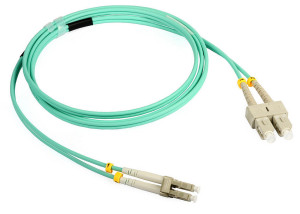
OM4 multi-mode fiber patch cords can connect high speed and legacy networks including Gigabit Ethernet, Fast Ethernet and Ethernet. They also support Fiber Channel and OIF applications, allowing extended reach upwards of 550m at 10 Gb/s for ultra long building backbones and medium length campus backbones. Besides, OM4 fiber patch cords support video, data and voice services in data centers and premises cabling in data networks including backbone, riser and horizontal. With an effective modal bandwidth (EMB) of 4700 MHz/km, OM4 fiber patch cords are also especially well suitable for shorter reach data center and high performance computing applications. OM4 fiber patch cables effectively provide a minimum reach of 125m over multi-mode fiber within the 40 and 100 gigabit Ethernet standards.
Fiberstore provides the broadest choice of fiber optic patch cords to the industry including OM3 fiber patch cable, OM4 fiber patch cable, MPO cable and other special fiber patch cords with multiple connector choices. Our OM4 fiber patch cable has armored and non-armored options. We make reliable and top quality OM4 fiber patch cords at an affordable price.
Posted by: jowang at
07:24 AM
| No Comments
| Add Comment
Post contains 569 words, total size 5 kb.
February 19, 2016
40G bandwidths are now being widely adopted within LANs and Data Centres. And 100G will soon be required within your local networks. Here comes the question: what type of fibre network you should choose when planning your 40/100 GbE migration. You have to consider your cabling infrastructure and how it will meet your current and future data requirements. The cables of choice for data center connectivity and what is recommended by the TIA are OM3 and OM4 laser-optimized multimode fiber. In this post, a comparison between OM3 and OM4 fibers will be given.
The IEEE 802.3ba 40/100G Ethernet Standard was ratified in June 2010 and specified parallel optics transmission for multimode fiber. OM3 and OM4 are the only multimode fibers included in the standard. OM3 and OM4 laser-optimized 50/125µm multimode fibers are the choice fiber type for connectivity in the data center. The fibers provide a significant value proposition when compared to single-mode fiber, as multimode fiber utilizes low cost 850 nm transceivers for serial and parallel transmission. Below we look at the differences between OM3 and OM4 multi-mode fibers. The picture shows laser-optimized multimode fiber cables.
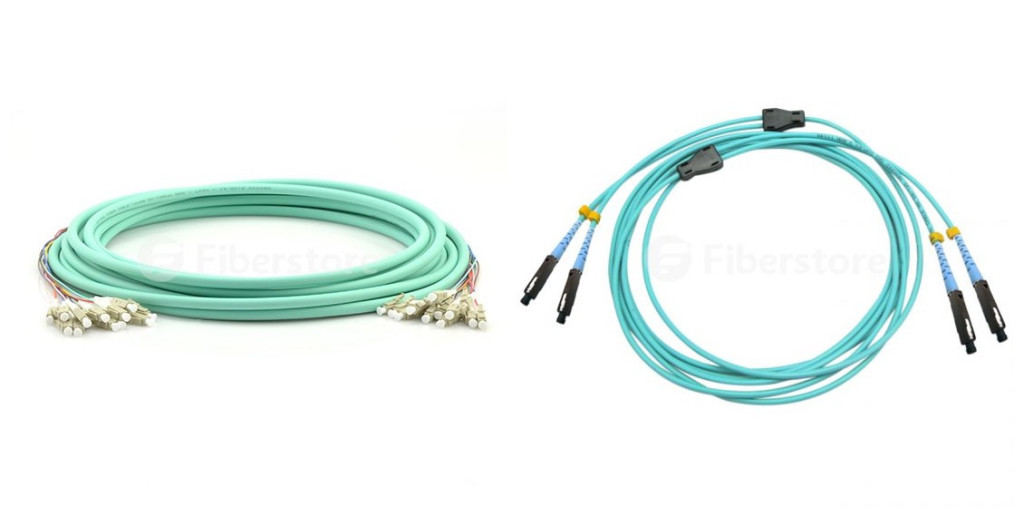
OM3 is fully compatible with OM4. The connectors are the same, the termination of the connectors is the same, the fibre core size 50/125 is the same, and both fibers are laser optimised multi-mode fiber (LOMMF). The difference is just in the construction of the fibre cable. The difference in the construction means that OM4 cable has better attenuation and can operate at higher bandwidth than OM3.
Attenuation: Attenuation is the reduction in power of the light signal as it is transmitted. It is caused by losses in light through the passive components, such as cables, cable splices, and connectors. The difference in OM3 and OM4 performance is in the loss (dB) in the cable. OM4 causes lower losses.
Dispersion: Dispersion is the spreading of the signal in time due to the differing paths the light can take down the fiber. Modal dispersion, which means that the spreading of the signal in time resulting from the different propagation modes in the fiber. OM3 specifies an effective modal bandwidth (EMB) of 2000 MHz/km, and OM4 of 4700 MHz/km, showing that OM4 can operate at higher bandwidth.
The cost for OM4 is greater due to the manufacture process and economies of scale that the production of OM3 benefits from due to the volumes currently produced. Costs vary depending on the construction type of the cable (loose tube, tight buffered, etc.). OM4 cable is about twice as expensive as OM3 cable. This means that for lots of products such as standard fibre patch panels, MTP cassette modules, fibre patch cords the cost difference is very small (as the volume of cable is small).
OM4 effectively provides an additional layer of performance that supports these applications at longer distances, as shown in the following picture. OM4 provides an opportunity to future-proof cabling infrastructure, for it can provide a minimum reach of 125m over multimode fiber within the 40 and 100 GbE standards. Additionally, OM4 provides additional reach at extended bandwidth at an overall cost still less than that of an OS2 singlemode system. In other words, OM4 provides a solution that allows more installations to avoid the significantly higher costs of singlemode systems.

It is important to note that OM4 glass is not necessarily designed to be a replacement for OM3. Despite the relatively long-standing availability of OM4, there are no plans to obsolete OM3 fiber optic cabling. Fiberstore offers you a wide range of cable choices for your 40G Ethernet applications, like OM3 and OM4 fiber optic patch cables. And we also offer other 40G components, such as QSFP+ transceiver, copper cable, active optical cable and QSFP+ cable. You can buy from us with confidence.
Posted by: jowang at
09:09 AM
| No Comments
| Add Comment
Post contains 655 words, total size 6 kb.
February 17, 2016
As the ever-growing demands for higher speed data rates, transmission network migration to 40G has already been the industry consensus. 40G products have currently been mass produced. Mellanox QSFP+ (quad small form-factor pluggable plus) modules offer you a wide variety of connectivity options for your 40 Gigabit Ethernet applications. This article gives a basic introduction to Mellanox 40GBASE QSFP+ modules.
Mellanox is a leading provider of optical network equipment. Mellanox QSFP+ is a Multi-Source Agreement (MSA) standard for high speed application, providing four channels of data in one pluggable interface. Each channel is capable of transferring data at 10Gbps and supports a total of 40Gbps. Mellanox 40G QSFP+ transceivers are SFF-8436 compatible and are electrically hot-pluggable, with four independently addressable transmit and receive channels. Mellanox QSFP+ transceivers are well tested on Mellanox switch to ensure optimal signal integrity and the best end-to-end performance. Two types of Mellanox QSFP+ modules are introduced in the following text.
Mellanox MC2210411-SR4 40GBASE-SR4 QSFP+ transceiver is a standard MSA multi-mode transceiver for 40 Gigabit Ethernet. It enables high-bandwidth 40G optical links over fiber terminated with MPO/MTP multifiber connectors and can also be used in a 4x10G module for interoperability with 10GBASE-SR interfaces. Mellanox 40GBASE-SR4 QSFP+ transceiver supports link lengths of 100m on OM3 multimode fibers and 150m and OM4 multimode fibers, operating at a wavelength of 850nm. The image below shows a Mellanox MC2210411-SR4 compatible 40GBASE-SR4 QSFP+ transceiver.
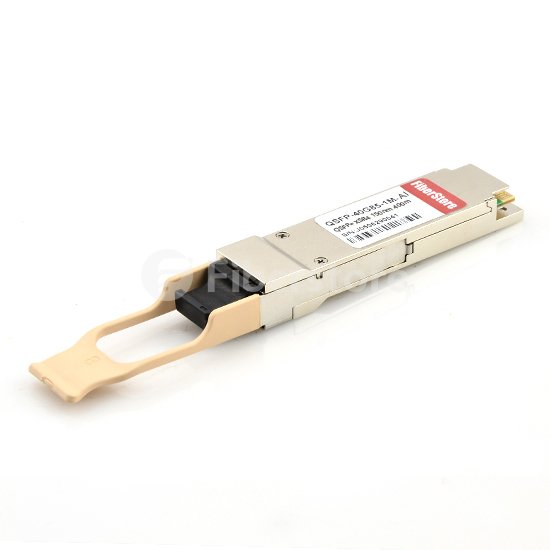
Mellanox MC2210511-LR4 40GBASE-LR4 QSFP+ transceiver is a standard MSA single-mode transceiver for 40 Gigabit Ethernet. It supports link lengths of up to 10km over single mode fiber with duplex LC connectors. 40 Gigabit Ethernet signal is carried over four wavelengths. Multiplexing and demultiplexing of the four wavelengths are managed in the device. It is compliant with the QSFP+ MSA and IEEE 802.3ba, and RoHS-6 compliant with built-in DDM interface. The image below shows a Mellanox MC2210511-LR4 compatible 40GBASE-LR4 QSFP+ transceiver.
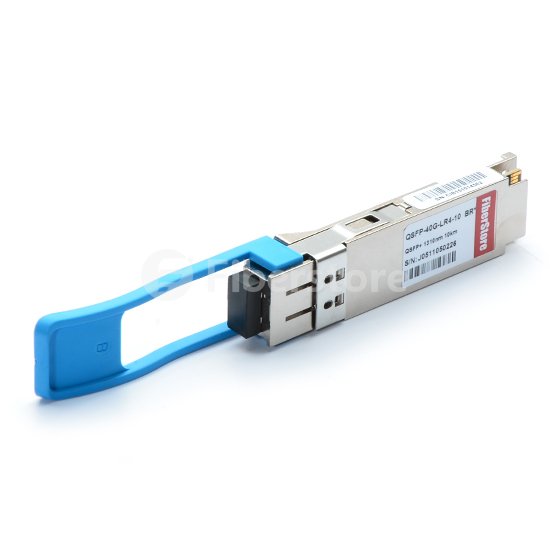
Mellanox QSFP+ transceivers provide outstanding performance for high-bandwidth applications, including 40 Gigabit Ethernet, QDR, FDR Infiniband, and other communications standards. In addition to meeting or exceeding InfiniBand Trade Association (IBTA) and IEEE standards, Mellanox certified modules are 100% tested on Mellanox equipment to ensure optimal signal integrity and the best end-to-end performance.
Nowadays, QSFP+ transceivers have been widely used by people as it can provide higher bandwidth. And other kinds of 40G products, such as direct attach copper cables and active optical cables, also become popular devices in 40 Gigabit Ethernet applications. Fiberstore is a professional manufacturer and web-base direct sales company focused on optical interconnect products including optical transceivers, fiber optic cables and accessories. We are able to provide customized and cost-effective solutions of high quality for all needs and specifications. We offer various kinds of 40GBASE QSFP+ transceivers branded by many famous companies. QSFP+ transceivers provided by Fiberstore are the most cost-effective standards-based QSFP+ modules. They are 100% compatible with major brands and backed by a lifetime warranty.
Posted by: jowang at
06:26 AM
| No Comments
| Add Comment
Post contains 502 words, total size 6 kb.
February 15, 2016
1G and 10G data rates are not adequate to meet the future needs of high-bandwidth applications. The requirement for higher data rates is being driven by many factors. Switching and routing, virtualization, convergence and high-performance computing environments are examples of where these higher network speeds will be required, which will drive the need for a migration from 10G to 40/100G interfaces. Upgrading you network from 10G Ethernet to 40G and 100G is not as easy as swapping out switches and line cards. How to more easily upgrade your network to 40/100G Ethernet? It will be introduced in the following text.
IEEE published the IEEE 802.3ba standard for 40 Gigabit and 100 Gigabit Ethernet in June 2010. Only the laser optimized multimode fiber (grades OM3 and OM4) are capable of supporting 40G and 100G Ethernet. 40G Ethernet and 100G Ethernet over multimode fiber uses parallel optics at 10 Gb/s per lane. One lane uses 1 fiber for each direction of transmission. 40G Ethernet requires 8 fibers. 100G Ethernet requires 20 fibers. The minimum performance that is needed to support 40 GbE and 100 GbE over multimode fiber is OM3 fiber for a distance of 100 meters. Cabling with OM4 fiber provides the capability to extend the reach up to 150 meters.
One challenge for upgrading your network to 40/100G Ethernet is readying the cabling infrastructure for 40/100G, experts say. Ensuring the appropriate grade and length of fiber is essential to smooth, seamless operation. This is a big consideration for users because it could mean re-wiring a significant portion of their physical plant, if not all of it. That could be an expensive and disruptive undertaking. At the physical layer, 40G Ethernet is essentially 4x10G "lanes". "100G is going to be even more of a challenge because now you're dealing with a whole new layer of physical infrastructure. You will have a whole new generation of optics, cables, everything will be a whole new generation at that point."
Migrating from 10 GbE (that uses two fibers in either a SC duplex or a LC duplex connector) to 40 GbE and 100 GbE will require a lot more fibers and a different type of connector. An effective migration strategy needs to provide a smooth transition to the higher Ethernet speeds with minimum disruption and without wholesale replacement of existing cabling and connectivity components. Optical fiber cabling is commonly deployed for backbone cabling in data centers for switch to switch connections and also for horizontal cabling for switch to server and storage area network connections. The use of pre-terminated optical fiber cabling can facilitate the migration path to 40G and 100G Ethernet.
All the components that are designed to migrate from 10 Gigabit to 40 Gigabit Ethernet are the same components that are used for 100 Gigabit Ethernet. The only difference is that a 100 Gigabit Ethernet connection is established using a Type B array patch cord that interconnects two, 12-fiber MPO connectors in the FX Ultra HD patch panels to one, 24-fiber MPO connector at the transceiver. The 100 Gigabit Ethernet, Type B array patch cord polarity is illustrated in the following picture. No changes to the patch panels or cabling are required. The 100 Gigabit channels can be added by using spare positions in the MPO adapter frames or by replacing the appropriate number of 40 Gigabit channels.
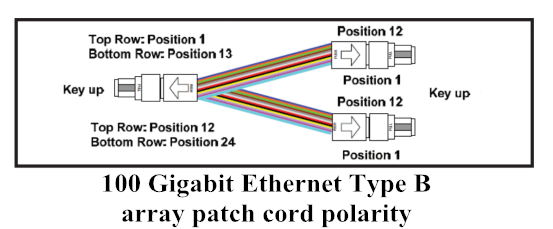
Fiberstore's pre-terminated optical fiber cabling provides an effective migration path to 40 Gigabit Ethernet and 100 Gigabit Ethernet using the same infrastructure by adding pre-terminated trunk cable assemblies and MPO adapter frames as needed. And we offer all kinds of connection choices for your 40 GbE and 100 GbE network applications. For example, HP JG709A compatible 40GBASE-CSR4 QSFP+ transceiver and Finisar FTL410QE2C compatible 40GBASE-SR4 QSFP+ transceiver, they are with high quality and you can buy from us with confidence.
Posted by: jowang at
07:04 AM
| No Comments
| Add Comment
Post contains 663 words, total size 6 kb.
February 01, 2016
There is no doubt that singlemode fiber systems can achieve great distances, but when it comes to the data center, deploying a singlemode solution designed to reach 10,000 meters is vast overkill in both capability and cost. In the data center, multimode solutions are the perfect fit. With speeds in the data center now increasing from 10 Gbps to 40 Gbps and eventually to 100 Gbps, different optical technologies and cabling infrastructure are required. OM4 has already been a preferable cabling choice. This article will mainly talk about OM4 optical fiber cabling.
OM4 is a laser-optimized, high bandwidth 50µm multimode fiber. It is optimized for the 850nm transmission of vertical-cavity surface-emitting laser (VCSEL)-based transceivers. The TIA-492AAAD OM4 detailed fiber standard was released in August 2009. Laser optimized multimode fiber allow designs of laser transmission systems utilizing multimode optical fiber without the use of mode conditioning cables. When paired with new low cost VCSEL technology, they are allowed for 10G transmission. A picture of OM4 cable is shown below.
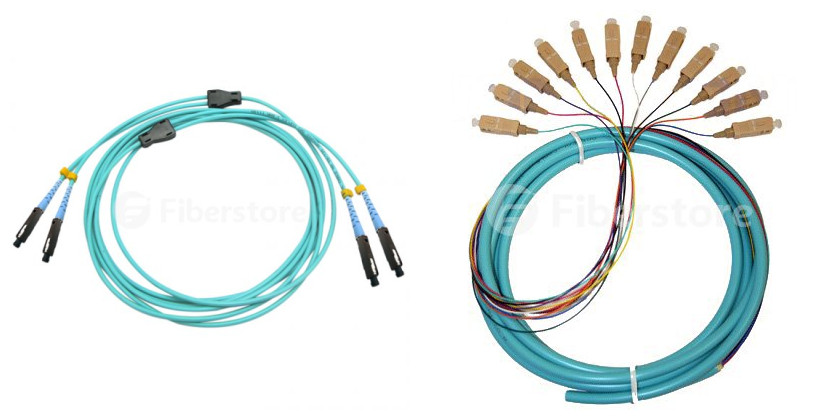
OM4 provides an opportunity to future-proof cabling infrastructure. OM4 is completely backwards-compatible with existing OM3 systems. As a result, these two grades of glass are interchangeable within the transmission distance limitations outlined above. The additional bandwidth and lower attenuation of OM4 provide additional insertion loss margin. As a result, users of OM4 gain additional safety margin to help compensate for less-than-ideal cabling installations as well as provide margin for degradation due to moves, adds, and changes over the life of the installation.
OM4 fiber has been on the market since 2005. The OM4 designation standardizes the nomenclature across all manufacturers so that the customer has a clearer idea of the product that they are buying. OM4 is completely backwards compatible with OM3 fiber and shares the same distinctive aqua jacket. OM4 was developed specifically for VSCEL laser transmission and allows 10Gb/s link distances of up to 550m (compared to 300m with OM3). The effective modal bandwidth for OM4 is more than double that of OM3. While OM3 fiber will still be future proof in most applications, allowing speeds of 10Gb/s up to 100Gb/s, OM4 fiber offers users longer length distances and more wiggle room in optical budgets.
It is important to note that OM4 glass is not necessarily designed to be a replacement for OM3. Despite the relatively long-standing availability of OM4, there are no plans to obsolete OM3 fiber optic cabling. For most systems, OM3 glass is sufficient to cover the bandwidth needs at the distances of the current installation base. Most system requirements can still be reliably and cost effectively achieved with OM3.
As increased bandwidth requirements are called out in new installations, particularly 40Gb/s and 100Gb/s standards, transmission distances over fiber optic cables contained in existing infrastructure may become increasingly limited. OM4 effectively provides an additional layer of performance that supports these applications at longer distances, thereby limiting the number of installations that truly require OS2 singlemode fiber. OM4 can provide a minimum reach of 125m over multimode fiber within the 40 and 100 GbE standards. OM4 is a "universal medium" and supports all existing multimode applications.
Choosing the right fiber for your network application is a critical decision. The throughput and reliability of a 40/100 Gigabit Ethernet installation is directly related to the cabling, the choice of connectivity, and proper installation. Fiberstore's superior cable and connectivity designs provides you with superior levels of performance and operation. Other than OM4, we also offer other kinds of cables and transceiver modules for your applications, such as 40G QSFP, 100G CFP, or QSFP+ cable. You can buy from us with confidence.
Posted by: jowang at
09:30 AM
| No Comments
| Add Comment
Post contains 618 words, total size 6 kb.
32 queries taking 0.0663 seconds, 76 records returned.
Powered by Minx 1.1.6c-pink.









